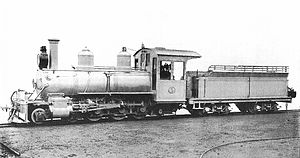CGR type B
| CGR type B SAR No. NG 27–32, 36–38 |
|
|---|---|
|
CGR type B
|
|
| Numbering: | CGR: NS 33-38 |
| Number: | 9 |
| Manufacturer: | WG Bagnall & Kerr, Stuart |
| Year of construction (s): | 1903-1913 |
| Retirement: | until 1931 |
| Type : | 2'C n2 |
| Gauge : | 610 mm |
| Length over coupling: | 13,535 mm |
| Fixed wheelbase: | 1,905 mm |
| Total wheelbase: | 3,988 mm |
| Service mass: | 20.6 t |
| Service mass with tender: | 41.7 t |
| Friction mass: | 17.0 t |
| Wheel set mass : | 5.7 t |
| Driving wheel diameter: | 838 mm |
| Cylinder diameter: | 298 mm |
| Piston stroke: | 406 mm |
| Boiler overpressure: | 124.0 N / cm² |
| Grate area: | 0.71 m² |
| Radiant heating surface: | 3.76 m² |
| Tubular heating surface: | 35.38 / 38.30 m² |
| Train brake: | Suction air brake |
The Cape Government Railways vehicles designated as Type B were steam locomotives with a 2'C wheel arrangement for 610 mm narrow gauge. They were procured from 1903 for use on the Avontuur Railway .
history
The locomotives were based on the design of locomotives Nos. NG 1 to 3 , which were used on the Hopefield Railway . Initially, 1'C was provided as in this case; the 2'C wheel arrangement was then decided because the leading bogie on the much more curvy Avontuur Railway promised better running properties. The design and appearance of the locomotives remained purely American, although they were procured from British manufacturers.
The SAR took over all six locomotives in 1910 and gave them the new numbers NG 27-32. 1911-13 the railway procured three more machines from Kerr Stuart and WG Bagnall , which were given the numbers NG 36-38. They had therefore compared with the first copies prolonged boiler tubes and thus a larger heating surface and were considered Improved B referred.
SAR class names for narrow-gauge locomotives were initially not introduced; this only happened in the late 1920s, when the former CGR locomotives were already scheduled for retirement. Possibly the (not otherwise occupied) class NG 8 was intended for these locomotives.
The type B performed most of the route service on the Avontuur Railway until they were replaced by newer locomotives. One copy was permanently moved to the Hopefield Railway during the First World War , and the Type B was also temporarily used in South West Africa and possibly Natal .
A locomotive, no. NG 27, was sold in 1927 to the Eastern Province Cement Company (EPCC), which operated a route branching off from the Avontuur Railway, about 19 kilometers long, over which the cement works was supplied with limestone. In 1930, when major repairs were necessary, the machine was replaced by a brand-new locomotive that corresponded to class NG 10 of the SAR.
The successor class of type B was class NG 9 of the SAR. Apart from deviations in the boiler dimensions, these locomotives supplied by Baldwin differed mainly in their Heusinger control from the Improved B , which were equipped with a Stephenson control.
The B and Improved B that remained with the SAR were retired and scrapped by 1931; no copy has survived.
literature
- Sydney M. Moir: Twenty-Four Inches Apart. The two-foot gauge railways of The Cape of Good Hope. 2nd edition (revised). Janus, Kempton Park 1981, ISBN 0-620-05460-3 .
- Leith Paxton, David Bourne: Locomotives of the South African Railways. A Concise Guide. C. Strui (Pty) Ltd., Cape Town 1985, ISBN 0-86977-211-2 .
Footnotes
- ↑ After Twenty-Four Inches Apart , NG 7 was intended for the Bagnall machine built in 1913 and NG 8 only for the two Kerr-Stuart machines built in 1914. On the other hand, in Locomotives of the South African Railways and other sources [1] ( page no longer available , search in web archives ) info: The link was automatically marked as defective. Please check the link according to the instructions and then remove this notice. the statement that the class NG 7 was probably intended for the 1'C locomotives of the Hopefield Railway.
